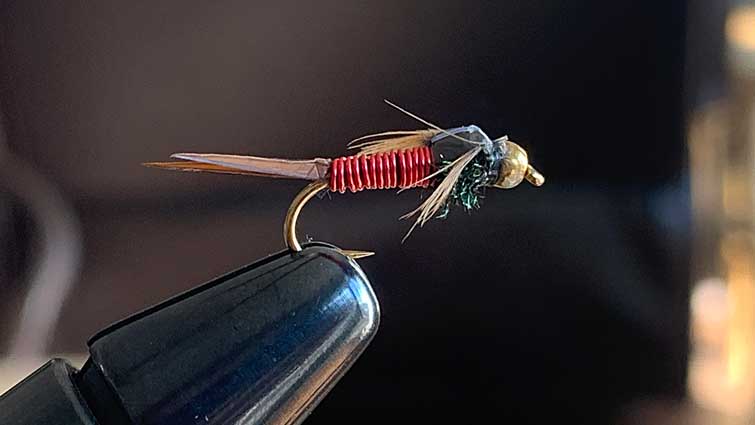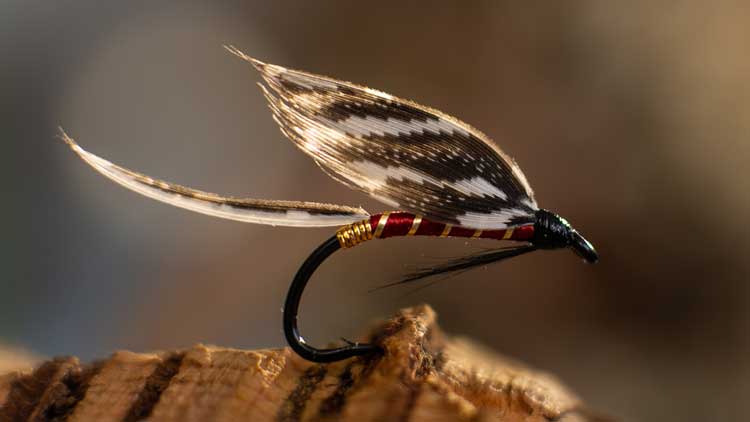Beginner anglers prefer dry fly fishing, but using nymphs always proves to be more productive. When it comes to fishing, nymphing skills are a must-have. If you don’t, you don’t need to worry, because we have all the information you require.
In a traditional sense, Nymphs are considered wet flies. These types of fly-fishing patterns refer to any fly fished under the water’s surface. Nymphs are designed to mimic eggs, larva, pupa lifecycles of insects. They also represent scuds, sow bugs, eggs and annelids. In modern fly fishing linguistics, "wet flies" reference traditional fly patterns developed in the 1800s.
There are various types of nymphs you can fly fish that include:
- Pheasant tail
- Hare’s ear
- Prince nymph
- San Juan worm
- Zebra midge
There are over 6000 fly patterns on the market today, with a good portion represented by nymphs.

What is the difference between a nymph and a traditional wet fly?
Most anglers use the term "wet fly" to refer to traditional winged wet flies that are swung, using a technique called a "wet fly swing". Nymphs even though they are fished subsurface resemble juvenile insects and typically will not have exaggerated wings like traditional wet flies or dry flies.
Nymphs can also have a weighted bead tied to the pattern's head to get the fly to sink faster. Below are a handful of categories of tying styles that nymphs can fall into.
Beadhead Nymphs
These are the most common nymph wet flies that anglers use. As the name suggests, they have a bead near the hook's eye to make them heavy. Even though anglers can add weight themselves, having this option is more convenient.
Non-Beadhead Nymphs
These nymph flies don’t have a bead attached for added weight. These are the simplest nymph flies, and Non-bead head nymphs are ideal for heavily pressured fishing regions.

Euro Nymphs
These nymph flies have a heavy-weight bead-head that will ride upside-down inside the water. These nymph flies are gaining more popularity in recent times as it allows them to get down quickly in the water column.

Soft Hackles
Soft hackle nymph flies imitate emerging insects. These flies can be dead, drifted, or swung in the current to ensure trout comes out.

Emergers
Emergers imitate insects that are transitioning in their life cycle. Trout fish take complete advantage of this transition vulnerability and come out. These flies are fished suspended in film or right below the surface, which is much higher than other nymph flies.

Is Nymph A Wet Fly?
As a whole, a nymph is a wet fly, but not in the traditional sense because it typically does not have extra material tied on for wings as a wet fly pattern. Nymph patterns are fished under the water's surface and help you to catch various fish. Many anglers use nymphs flies to catch trout.
Many types come under this category, and you can choose depending on what and how you want to fish. Nymph flies always ensure productive and efficient results when it comes to fishing.

How Do You Fly Fish Nymphs?
Nymphing is the fly fishing technique that uses emerger or nymph patterns. You can use this fly fishing technique in moving and still waters to get the most out of your fishing experience. Here are the beginning steps you can take to fly fish nymphs:
1. Setting Up
The first thing you need to do is set up your fly rig. You can use a full leader that can range between eight and ten feet in length. Once your leader is ready, you can tie your first nymph fly.

Once the fly is on, you need to use fishing pliers to crimp the barbs down and de-barb the hook. Doing this will ensure an effective removal process of the nymph fly after you have landed a fish of your choice.
2. Add weight
Adding weight is optional if you have a bead head nymph fly. On the other hand, if you feel that the fly is too light, you can add to ensure it goes deep enough in the water column to attract feeding fish. The decision to add more weight or not will depend on the water depth to reach the fish's feeding zone.

You can start with two Number Zero split shots and place them at least twelve to sixteen inches above your fly. You can also use wrap weights or putty if you don’t like split shots.
Depending on the water depth, you can begin by adding more weight and then remove it as you go along. If you are fishing in deep water, it is best to add one or two additional weights. However, if the water is shallow, you might not need to use weights at all.
3. Adding The Strike Indicator
Once you have added the nymph fly and the weights, it is time for you to add the strike indicator. These indicators are additional attachments to your line, which will aid you in seeing if a fish has taken a strike or bite. There are numerous strike indicators on the market.

4. The Cast
After all the attachments, such as weights and indicators, your cast will feel different. It might feel heavier than what you are used to, but you don't need to worry about it. That is because you can begin casting slowly first until you get used to the line's weight.
However, an important thing to note is not to cast your line forty yards upriver. You can start by casting at least three quarters upriver. After you are comfortable with this, you can practice a roll cast in the river.
It is essential to go slow and not cast too fast, or your line will tangle in many ways. Because of this, you might spend your time untangling the mess more than fishing successfully.
What Type Of Fly Is A Nymph?
A nymph is a wet fly that will easily be found in lakes, ponds, rivers, and streams. These flies are found under aquatic vegetation, below or above rocks, sand, fallen tree branches, etc. These flies don't have wings, and they can't fly in the insect stage.
Instead, a nymph fly will hunt and scavenge for food by crawling along the stream-bed. That means that the nymph lives underwater at all times. Because of this, nymph fly patterns are used to fly fish underwater.
The majority of nymph fly patterns tied for fly fishing can fall into 9 main categories.
- Midges
- Mayflies
- Caddis
- Stoneflies
- Annelids & Leeches
- Egg Patterns
- Damsel & Dragonflies
- Scuds, Shrimp and Sow Bugs
How Can You Tell The Difference Between A Nymph And A Dry Fly?
There are many ways you can tell the difference between a nymph and a dry fly. Here are the top ones that will help you understand the main differences:
1. Where They Sit
The main difference between a nymph and a dry fly is their dwelling place. Dry flies sit on top of the water while nymphs constantly live under the water. The dry flies will be over the water and resemble full-grown flies, insects, rodents, and much more.
On the other hand, nymphs inside the water will imitate emergers, nymphs and aquatic shrimp, and much more. The difference in appearance also comes from their habitat and where they dwell most of the time.

2. Appearance
A dry fly will always have a lighter hook and larger collar/hackle than most nymph flies. If you find a fly made of elk hair other stiff materials, it is most likely a dry fly.
When it comes to nymphs, you can tell if it is one through the material and size. If the material is soft and the size is small, it is most likely a nymph flies. Nymph flies also have weight added to them near the top of the hook that you can look for.
3. Imitation
A dry fly is a lightweight fly that always imitates an emerging insect. However, nymphs imitate the larvae that crawl on the bottom of the water. Nymphs always imitate the transition of a life cycle stage of the fly or insect.
4. Different Subcategories
Even under nymphs and dry flies, you will find various subcategories. When it comes to nymphs, you can choose many patterns that are best for your fishing technique. All these patterns and types will have a unique function.
In the same way, dry flies also have various subcategories you can choose from. Each fly shop will have a unique selection to offer when it comes to these subcategories.
Understanding nymphs and their fly fishing technique can help you apply them to your next trip. It will allow your fishing to be more skillful and fruitful in the long run.
About the Author
Matthew Bernhardt, a third-generation Coloradan, grew up at the forefront of the state’s fly-fishing revolution, enjoying time on the water, side by side with experienced guides and lifelong anglers.
By combining his passion for fly-fishing with input from other experienced fly-fishers and guides and his fine arts degree from Colorado State University, Matthew spent five years carefully developing the Drifthook Fly Fishing System, built to help every angler catch more trout.







